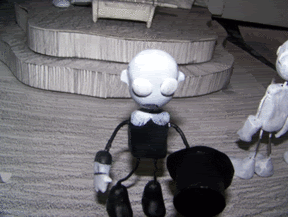I've always found this kind of therapy very interesting. I've known about those tests they give children sometimes--the ones in which they ask you to draw your family and the positioning and size of certain family members can reflect their living situation. It's an effective way of seeking the root of one's problems. Though I'm not sure that all art done as therapy is 'art' {by even my loosely fitting definition}, I don't think it's impossible to make art that is therapeutic. I find art therapy, in the context of expressing and discovering one's true anxieties, is not so much like the studio art we make but more as a visual map of the mind. It's a recollection, or a sensation, or some trial. It doesn't make it any less valuable than 'art', but it puts it in a completely different category.
1. I guess art therapy would entail the process of making something, whether it's a painting, drawing, or craft, that expresses your deeper anxieties or dreams to either yourself or the person who is attempting to get to the root of your more troubling issues. Yet it can just as well provide a busy, mediative, and focused task that takes one's mind off their current strife.
2. Sometimes. Mainly when it comes to rendering my pieces, either as sketches or as drawings, I am at my most reflective. I'm at the base, primordial pool of some idea and hashing it out to make it work as an image, and during this process I can forget about all my problems pertaining to anything else other than what I'm working on and the work tends to carry on more subconscious influences reflected in either the stroke of my hand or the energy in my drawing. When I get angry I tend to draw lots of contorted things, like monsters. When I'm content, there's a lot more humor in my work.
3. It can help them to express what might trouble them and what the more ideal situations they would prefer might be. Also, there's always a very strong sense of satisfaction and pride when someone swings along and tells you how great your work looks, which can give that someone the boost in self-esteem they probably need. Art therapy is a great method for this because just about anyone can pick up a tool and draw with it, whether they have use of their hands, feet, or mouth--just about anyone can artistically express themselves. There are so many psychological factors in art as well, even down to the very use of certain colors. A painting, drawing, or object can tell a lot about the person who made it, which will make it easier for people who don't have special needs to understand those with them.
4. Yes. When I was very displeased with things going on back home, I started to make plushies. I wanted something to hug and something cute to look at that would be yet another thing to help me forget about a less than ideal situation going on hundreds of miles away. I tend to craft/sculpt more when I'm upset as well as draw monsters or characters sympathizing with me. When I'm happier, I don't tend to make a whole lot of art.
5. Eh...sort of. I mean, I sort of do. I think if helping others get over their issues with art works well enough, I ought to do something for it. But it's not everyone's bag.
6. I guess...I mean, I can see a relationship between this video and how everyone makes their work. Most if not all of us can't quite make work about something we don't care about {or we'd be in Illustration--no offense; what I mean is that they'll take commissions to do work they often don't care about at all}. But even so, other than the 90% skill that goes into our work, at least about a solid 5% reflects how you're feeling in some fashion. It could be something as subtle as the way or the speed in which you made something and not so much the final piece.
7. To you, perhaps. With me, it's hit and miss. When you had your more atmospheric paintings, I did feel a certain calm when I looked upon them. But some others didn't have much an effect on me. Other than me trying to remember where they might be from, I'm only paying attention to how it's rendered.
8. Yeah. I'm pretty sure all of us might start taking different directions right away, since about half of us are probably just submitting to academic standards. But if it doesn't happen right away, I know it will happen eventually. Very few artists in the past, in fact none that I can think of now, continued to make the same work after they left their educative roots for the rest of their lives. Things change, inspiration changes, skills grow, new things are learned, and old things may be forgotten.
My artwork is somewhat therapeutic. I have to admit, a year ago when I made my stop-motion piece, I found the process to be harrowing yet engaging. Now I'm beginning to suspect the last one I made might be the last for a long time. I move on from one medium to another quite often. It's not that I can't find something I like to do, but I love discovering new ways to make things. And through experience, that discovery is better made when you take a break from one media and return to it later. I still draw to occupy myself through boredom, and I make things to take my mind off of stress.

No comments:
Post a Comment